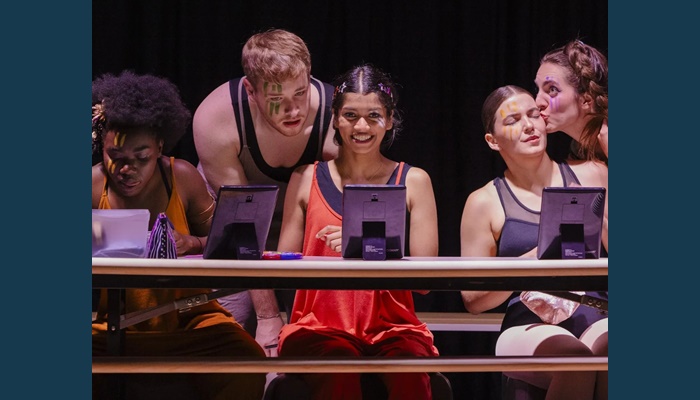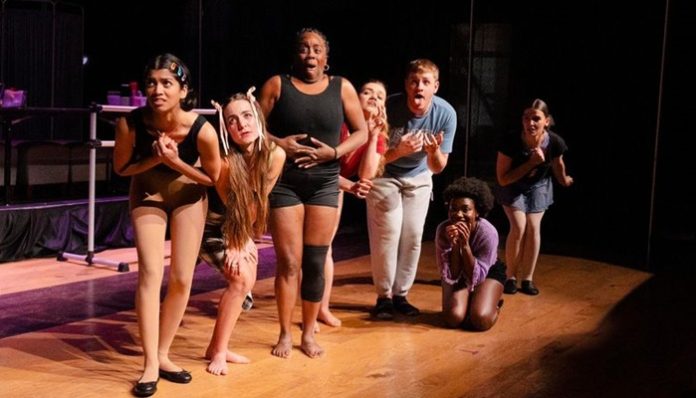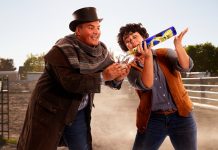SALT LAKE CITY, Utah, July 9, 2024 (Gephardt Daily) -- When a show kicks off with a group of eight grownups, playing 13 and 14-year-olds, all dressed in jaunty sailor suits and hats, performing a very intense and earnest tap number, it doesn't take me long to conclude I'm going to be mesmerized.
This sassy opening scene sets the tone of Voodoo Theatre Company's last play of the current season, "Dance Nation," by Clare Barron, which was a 2019 finalist for the Pulitzer Prize for Drama.
The show received its world premiere Off-Broadway at Playwrights Horizons in April 2018, and this is the Utah premiere. The play, set in Liverpool, Ohio, follows seven teenage dancers (because one injures herself badly at the end of the sailor number), all played by adults, in an obsessively competitive studio, attempting to claw their way to the top at Nationals in Tampa Bay.
It's hard to say exactly why shows about young dancers are so fascinating, but anyone who has been glued to series' such as "Dance Moms," "Cheer," and even "Toddlers and Tiaras" can verify their intrigue. In this piece, I think it's about watching the dichotomy of these performers; essentially still children, but expected to have the focus, stamina and willpower of adults. It's intriguing to watch the characters ride the line between being youngsters and adults as they glance towards the scary world of being a grown up.
Dancing, of course, is also a way to have some power over bodies that are changing rapidly, galloping towards adulthood whether we like it or not. And as we discover in the course of the play, movement brings the teens a sense of joy, abandon, and intimacy. It's a way to bond, and as a result, in the dressing room, the team feels close enough to discuss such subjects as periods, masturbation and circumcision. It's in the dance studio that they feel free, but it's also in the dance studio that they feel the most threatened.
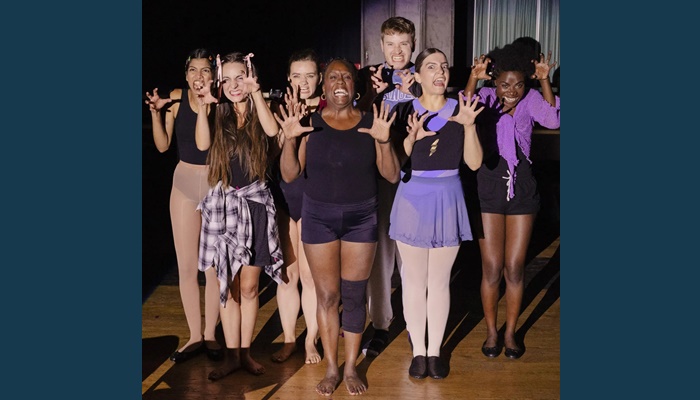
The play, directed by Ali Lente and assistant directed by Jack Cobabe, opened at the Alliance Theater in Trolley Square on Friday, and continues through this week, with shows on Friday, July 12 and Saturday, July 13 at 7:30 p.m., with additional shows on Saturday, July 13 at 2 p.m. and Sunday, July 14 at 6 p.m. For more information, and for tickets, click here.
The company describes its mission as "striving to perform plays actors want to act in, and audiences want to see." Its mission statement adds: "We aim to engage and enrich our community through thought-provoking, emotional, and thrilling plays," which Voodoo has certainly achieved here.
Though the dancers are dressed alike at the beginning, we soon start to learn the differences in their personalities, which are hilariously described in the script, from Ashlee: "future president of a post-apocalyptic USA," to Sofia, who is described simply as: "knows what's up." The studio is run with an iron fist by Dance Teacher Pat, who wants to take his troupe to regionals then nationals with an acro-lyrical number called "World on Fire," about the legacy of Gandhi (yep you heard that right). When this project is announced, the dancers become competitive about receiving the title role, so Dance Teacher Pat also creates a role of the spirit of Gandhi, and in a major upset, the star dancer of the team, Amina, is not cast in either role. However, as you might guess, this casting decision is not quite the end of the story....
The narrative arc of the show is pretty straightforward, but the emotional arcs of the troupe are much more chaotic and colorful. The piece is a celebration of the incredible intensity of female friendships, where best friends can turn to enemies on a dime, and connections swell and burst like delicate bubbles. In this world, every emotion is important and big and serious but then can be forgotten in a moment.
We are also introduced to the home lives of some of the characters, by way of scenes with their mothers, who are all played by the same person. In solo monologues, the dancers also reveal their internal struggles, and at times we also fast forward to their older selves, and learn the challenges they have faced.

The cast members, across the board, are brilliant, directed with a light touch by Lente and Cobabe, who have obviously given their actors plenty of room to create and play. Every single actor is fierce, sometimes bordering on feral, never slipping into "cutesy" performances because they are playing younger characters. They also confidently handle the tilt-a-whirl twists between naturalism and surrealism that Barron writes into the script.
I also love how completely absorbed each character is with their own journey. This is particularly evident in the performances of Carlie Young as Sofia, who is absolutely hilarious in her offbeat intensity (she also has my favorite moment of the show, which I won't give away, but it involves some special warpaint) and Suni Gigliotti as the star dancer Amina, with her always perfect hair and dance outfits that harshly conceal a possibly more fragile, unsure interior.
The always-outstanding Dee-Dee Darby-Duffin delivers my favorite monologue of the show, as her character Ashlee revels in the newly discovered power of her body: "That’s what I’ve got inside this tiny f****** body of mine, and I don’t have to deny it. I don’t have to disown it, I don’t have to be ashamed of it, I can shout it from the rooftops.…" Ashlee asks herself, "What am I going to do with all this power?" She answers, "I don’t know." Later, we find out what she does do with "all that power" when she reaches high school. Stacey Jenson is also excellent as all the dance moms, as she effortlessly morphs into each different character, most of whom only appear in a single scene.
I also loved the creativity of Laura Elise Chapman's portrayal of Maeve, who is described as the "oldest and least talented dancer on the team." Chapman's performance is utterly quirky, eccentric, and relentlessly inventive whether she's talking about her passion for wolf preservation, fiddling obsessively with her long hair, or planting random kisses on the other girls. She's like the strange little lovechild of Alice through the Looking Glass and a vampire. But there's also an edge of melancholy to her performance, as she describes in her monologue how she used to fly in her dreams. "And one day I’ll forget that I ever used to fly. Because the truth is -- I did. I did actually have the power to fly. Or to float, or whatever. But somehow, along the way, I forgot about it. I forgot all about it. It was the coolest thing I ever did. And I forgot it. I forgot it ever happened." There is the implication in her speech that it may also be an analogy for her journey with dance, which is exquisitely sad.
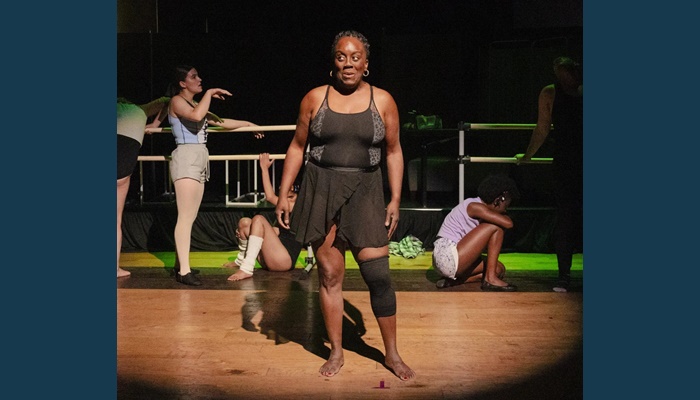
Another element that was a lot of fun on opening night, which was sold out, was that the audience really responded verbally to the show. During the more elaborate numbers, when the music is pulsing, the lights are flashing and the dancers are giving it their all and then some, the crowd was hooting and hollering, and they also responded out loud to different characters, with sympathetic sighs for Luke, the only male member of the dance troupe, played with gentle bemusement by Darrin Burnett, and also during a rather sweet scene where Connie (Saey Kamtekar) plays with her horse collection, reminding us how young these characters really are. There was also a visceral response during a scene when Dance Teacher Pat (Jason Hackney) turns on Zuzu (Betty Kalunga) for not performing up to standard.
The production values are also excellent. The choreography, by Sammee Jackman, is fun and playful and chock-full of pizzazz. The set, which is not credited to a designer, depicts the dance studio, with the front section used for the group numbers and to represent other places, while behind, there is a raised level with benches and tables that serves as the dressing room. I think a set design that was any more complicated could have muddied the action, which at times is slightly and deliberately chaotic. The lighting by Tay Rushton and sound by Grace Heinz really amp up the dance numbers, but also nicely highlight other scenes without ever being overpowering.
There isn't a designer credited, but I loved the costumes. I'm always intrigued by the outfits dancers sport when they're onstage, but then the ultra-comfy ensembles they wear in the dressing rooms and at home, and the rather fun juxtaposition of the two at times, such as a clingy dance outfit with large fuzzy slippers. The dancer's ensembles for the group numbers are wonderfully earnest and absolutely hilarious; for the Gandhi number, they wear loose dungarees, almost like onesies, in fire and earth colors that make them look like odd, utilitarian babies, with stripes of warpaint on their faces. (I remember one modern dance performance that my friends and I did for an exam at school when we were about 16; there was one part when we paraded across the stage in ballgowns, holding sparklers. I'm not sure why. I still cringe when I think about it, It was truly awful.)
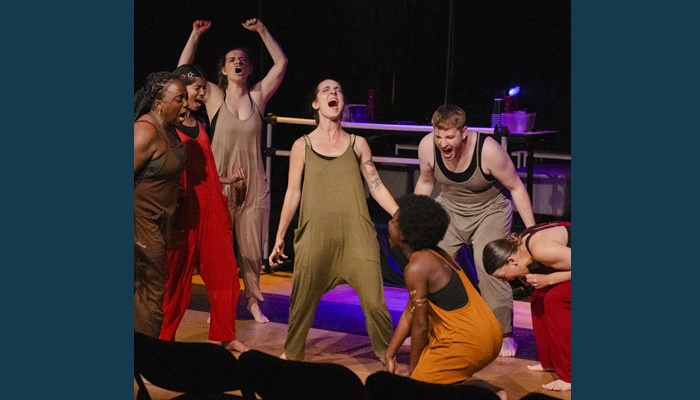
After the controlled mayhem of the rest of the show, the ending feels like a knife to the heart. Amina, alone and dressed in harsh black sequins, her hair and makeup flawless as always, dances frantically. "I'm going to win. I'm going to win. I'm going to win. Not because of you. I am going to do it myself," she says. "Over the years, I will watch, as others fall away, give up, lose courage, I will keep going." She concludes her monologue: "I rode the wave, and others kept falling along the way. But I kept riding, until I was alone. I was alone. I was alone." It's a stark contrast to the beginning of the play, with the merrily dancing band of sailors. Amina no longer has her wolf pack, and it's not until they are all gone that you realize how isolated and alone just one dancer, and by extension, one person, can be.
For more information about the show, and for tickets, click here.

